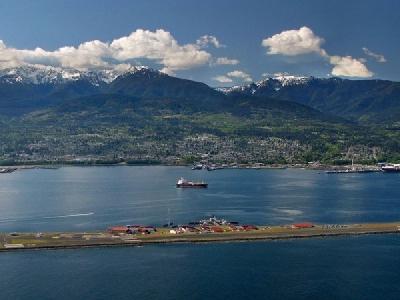
Posted on April 12, 2018
By Paul Gottlieb, Peninsula Daily News
A carpet of sand and gravel would cap buried logs, woody debris and carcinogenic pollutants that contaminate sediment at the bottom of Port Angeles Harbor under a $32.1 million draft plan recommended by a five-party group of governments and businesses.
Representatives from the city of Port Angeles, Port of Port Angeles, Nippon Paper Industries USA, Merrill & Ring timber management company and Georgia-Pacific LLC pulp and paper company presented the 782-page draft Remedial Investigation and Feasibility Study in person Friday to the state Department of Ecology’s Olympia headquarters, Nathan West, director of the city Department of Community Development, said Monday.
“It was really important to have in-person communication, to talk about the decision-making process and the manner in which the alternatives were selected by the group, and also to show that we have a group that is committed to moving the process forward,” West said.
Ecology will review the draft plan for the Western Port Angeles Harbor Study Area and approve a cleanup remedy, Rebecca Lawson, Ecology’s southwest region manager, said Monday.
“The main thing to remember is, this is the first draft of the report,” she said.
“We’re not ready to start public comment yet.”
The plan was five years in the making and was put together by the five governments and businesses called the Western Port Angeles Harbor Group.
Cleanup will take an estimated six years, according to the report.
Chris Hartman, the port’s director of engineering, said cleanup will be monitored for 15 years after the project is completed.
“We are very confident in the proposed alternative,” he said.
Dredging was not recommended, although Lawson said Ecology intends to consider it an option.
“Given the buried logs and debris present in the sediment bed, subtidal dredging would result in significant releases of contaminants into the water column, and dredging residuals would require capping to achieve cleanup standards,” according to the summary.
Hartman said the dredging alternative, which he called “The Big Dig,” would have cost $169 million.
At the other end, solely monitoring the harbor would have cost $1.25 million.
The Western Port Angeles Harbor Study Area is shaped like a wishbone with the two points connected by a line that forms the eastern boundary of the study area.
The entire area covers the harbor east to the end of Ediz Hook and lies just west of the former Rayonier pulp mill site, where marine waters are being cleaned up under a separate plan being put together by that site’s owner, Rayonier Advanced Materials.
The sediment cleanup area includes the city’s shoreline and encompasses slightly more than half of the western harbor.
About 9,700 cubic yards in 2 acres of intertidal area and nearshore soils would be excavated and capped to restore aquatic habitat near Nippon’s former administrative office building at the base of Ediz Hook, now occupied by McKinley Paper Co., the dormant paper mill’s new owner.
Another cleanup area consists of 37 acres of sediment in the inner harbor that would be covered with 2 feet of sand, gravel or both.
The area includes the inner harbor, where the sediment tests for higher concentrations of metals, combined dioxin-furan toxic equivalent and PCBs.
A 183-acre area closer to the center of the harbor would be capped with a 6-inch layer of sand, gravel or both in hopes the clean sediment would be recolonized by benthic organisms.
“Applying this approach to eelgrass meadows in parts of [the sediment management] subtidal area would allow cleanup levels to be achieved throughout the western harbor within 10 years,” the summary said.
Hartman said the material would likely be applied by crane and bucket from a barge.
The barge work would take place from July to February to protect migrating salmon.
It would require 273,900 cubic yards of sand and gravel, or 6,900 dumpsters of 40 cubic yards each.
A 942-acre portion of the western harbor that exceeds sediment cleanup levels would undergo monitored natural recovery without capping, according to the plan.
That area “poses lower potential risks to human health and the environment, and because of the large size and proximity to the working waterfront, presents significant implementability challenges for remediation,” according to the report.
The Remedial Investigation and Feasibility Study was prepared under an agreed order between the five entities.
Port and city insurance is expected to cover cleanup costs for those two public entities, West and Hartman said.
The 75-acre Rayonier site, where the pulp mill shut down production in 1997 and buildings have been razed, has sat vacant for 21 years and contains Native American burial remains.
Source: Peninsula Daily News





